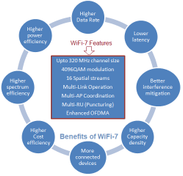6G Wireless: Advantages and Disadvantages
Advertisement
This page explores the advantages and disadvantages of 6G wireless technology, including its basics and key features.
What is 6G Wireless?
Introduction: 6G refers to the sixth generation of wireless technology. Research began in 2019 to develop 6G wireless technology, following its predecessor, 5G. The 5G wireless network was launched in several U.S. cities in April 2019.

The goal of 6G is to fulfill the 5G vision and meet the following objectives:
- Wisdom connection: Intelligent connectivity with the help of AI (Artificial Intelligence).
- Depth connection: Deep connectivity.
- Holographic connection: Seamless coverage anywhere using AR (Augmented Reality)/VR (Virtual Reality).
- Ubiquitous connection: Connectivity covering Space, Air, Ground, and Sea.

Figure 2 depicts a 6G network architecture covering everywhere with 6G connections. As shown, 6G communications are provided everywhere with the help of drones, satellites, RRHs (Remote Radio Heads), VLC (Visible Light Communications), BSs (Base Stations), and 6G network equipment mounted on moving objects.

The table above highlights key 6G wireless features.
Benefits (Advantages) of 6G Wireless
Here are the benefits or advantages of 6G wireless:
- Higher Connection Density: Designed to support a higher number of mobile connections than 5G, around 10 x 10^5 per Km^2.
- Revolutionizing Healthcare: Eliminates time and space barriers through remote surgery and guaranteed healthcare workflow optimization.
- Improved Indoor Coverage: Addresses challenges with indoor coverage using femtocells or Distributed Antenna Systems (DASs).
- THz Frequency Advantages:
- THz waves readily absorb moisture in the air, making them useful for high-speed, short-range wireless communications.
- Offers narrow beams and better directivity, resulting in secure communication due to strong anti-interference capabilities.
- High wireless bandwidth (several tens of GHz) from 10^8 to 10^13 GHz can deliver higher communication rates in Tb/sec.
- Possible lossless transmission between satellites in space communication.
- Beamforming and massive MIMO multiplexing gain helps overcome rain attenuation and fading propagation to meet urban coverage requirements.
- Terahertz wave’s photon energy is very low (about 10^-3 eV), offering higher energy efficiency.
- THz waves can penetrate substances with less attenuation, which can be used for special communication means.
- Visible Light Communication (VLC):
- Leverages the benefits of LEDs such as illumination and high-speed data communication.
- VLC does not produce EM (electromagnetic) radiation, so it is not susceptible to external EM interference.
- VLC also helps build network security.
- High Data Rate and Low Latency: Offers very high data rates (Tb/sec) and very low latency (sub-ms), enabling many new applications.
- Virtualization of Network Components: Will virtualize additional components, such as the PHY and MAC layers, which currently require dedicated hardware implementations. This virtualization will decrease the costs of networking equipment and make massively dense deployments in 6G economically feasible.
Challenges (Disadvantages) of 6G Wireless
Here are the challenges, rather than definitive drawbacks, of 6G wireless. As the technology is still under research and development, specific drawbacks cannot be concluded until 6G systems are installed for trial and testing.
- Cell-less Architecture and Multi-Connectivity: Seamless mobility and integration of different kinds of links (THz, VLC, mmWave, sub-6GHz) require perfect scheduling. In cell-less architecture, the UE connects to the RAN and not a single cell, posing a challenge to designing a new network architecture.
- THz Frequency Challenges: Since 6G uses THz frequencies for part of its communications, the drawbacks of THz can be considered drawbacks of 6G wireless technology. The terahertz frequency refers to the spectrum between 0.1 to 10 THz EM (electromagnetic) wave with a wavelength of 30 to 3000 micrometers.
- THz signals are very sensitive to shadows, which significantly impacts coverage.
- Lower-frequency terahertz frequencies incur larger free space fading.
- Ultra-large-scale antenna is a major challenge in THz, requiring high bandwidth and massive quantitative high resolution.
- Processing power is a major challenge in designing low-power and low-cost 6G devices.
- VLC Challenges: Since 6G uses visible light frequencies for part of its communications, the drawbacks of VLC can be considered drawbacks of 6G wireless technology. Visible light uses wavelengths from 390-700 nm.
- Energy Consumption: Managing a large number of terminals and networking equipment requires a more efficient and less energy-consuming 6G system. Fulfilling this requires new challenges in network and terminal equipment circuitry and communication protocol stack design. Energy harvesting strategies are being adopted to handle this requirement.
Advertisement
 RF
RF


